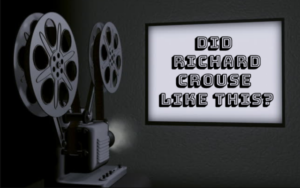Posts Tagged ‘Kate McKinnon’
Read the whole thing HERE
Tags: America Ferrera , Barbie , fantasy comedy , Greta Gerwig , Issa Rae , Kate McKinnon , Margot Robbie , Mattel , Noah Baumbach , Rhea Perlman , Ryan Gosling , Will Ferrell Richard Sez | Comments Off on CTVNEWS.CA: How Barbie’s massive marketing campaign worked so well
Watch the whole thing HERE
Tags: America Ferrera , American Prometheus , Barbie , biographical thriller , Casey Affleck , Christopher Nolan , Cillian Murphy , Emily Blunt , fantasy comedy , Florence Pugh , Greta Gerwig , Issa Rae , J. Robert Oppenheimer , Josh Hartnett , Kai Bird , Kate McKinnon , Kenneth Branagh , Margot Robbie , Martin J. Sherwin , Matt Damon , Mattel , Noah Baumbach , Oppenheimer , Rami Malek , Rhea Perlman , Robert Downey Jr , Ryan Gosling , Will Ferrell Film Review | Comments Off on CP24: RICHARD ON WHY “BARBENHEIMER” TOPPED THE WORLDWIDE BOX OFFICE CHARTS.
Watch the whole thing HERE
Tags: America Ferrera , American Prometheus , Barbie , biographical thriller , Casey Affleck , Christopher Nolan , Cillian Murphy , Emily Blunt , fantasy comedy , Florence Pugh , Greta Gerwig , Issa Rae , J. Robert Oppenheimer , Josh Hartnett , Kai Bird , Kate McKinnon , Kenneth Branagh , Margot Robbie , Martin J. Sherwin , Matt Damon , Mattel , Noah Baumbach , Oppenheimer , Rami Malek , Rhea Perlman , Robert Downey Jr , Ryan Gosling , Will Ferrell Film Review | Comments Off on CTV NEWS AT NOON: “BARBENHEIMER” TOPS THE BOX OFFICE CHARTS.
Saturday, July 22nd, 2023
Watch the whole thing HERE
Tags: America Ferrera , American Prometheus , Amy Sedaris. Will Ferrell , Ayo Edebiri , Barbie , Ben Platt , biographical thriller , Caroline Aaron , Casey Affleck , Christopher Nolan , Cillian Murphy , comedy , Emily Blunt , fantasy comedy , Florence Pugh , Greta Gerwig , Issa Rae , J. Robert Oppenheimer , Jimmy Tatro , Josh Hartnett , Kai Bird , Kate McKinnon , Kenneth Branagh , Margot Robbie , Martin J. Sherwin , Matt Damon , Mattel , Molly Gordon , Nathan Lee Graham , Nick Lieberman , Noah Baumbach , Noah Galvin , Oppenheimer , Owen Thiele , Patti Harrison , Rami Malek , Rhea Perlman , Robert Downey Jr , Ryan Gosling , Theater Camp , Will Ferrell Film Review | Comments Off on CTV NEWS AT SIX: NEW MOVIES AND TV SHOWS TO CHECK OUT THIS WEEKEND!
Saturday, July 22nd, 2023
Watch the whole thing HERE
Tags: America Ferrera , American Prometheus , Barbie , biographical thriller , Casey Affleck , Christopher Nolan , Cillian Murphy , Emily Blunt , fantasy comedy , Florence Pugh , Greta Gerwig , Issa Rae , J. Robert Oppenheimer , Josh Hartnett , Kai Bird , Kate McKinnon , Kenneth Branagh , Margot Robbie , Martin J. Sherwin , Matt Damon , Mattel , Noah Baumbach , Oppenheimer , Rami Malek , Rhea Perlman , Robert Downey Jr , Ryan Gosling , Will Ferrell Film Review | Comments Off on CTV NATIONAL NEWS: RICHARD ON THE “BARBENHEIMER” PHENOMENON.
Saturday, July 22nd, 2023
Listen to the whole thing HERE
Tags: America Ferrera , American Prometheus , Amy Sedaris. Will Ferrell , Ayo Edebiri , Barbie , Ben Platt , biographical thriller , Caroline Aaron , Casey Affleck , Christopher Nolan , Cillian Murphy , comedy , Emily Blunt , fantasy comedy , Florence Pugh , Greta Gerwig , Issa Rae , J. Robert Oppenheimer , Jimmy Tatro , Josh Hartnett , Kai Bird , Kate McKinnon , Kenneth Branagh , Margot Robbie , Martin J. Sherwin , Matt Damon , Mattel , Molly Gordon , Nathan Lee Graham , Nick Lieberman , Noah Baumbach , Noah Galvin , Oppenheimer , Owen Thiele , Patti Harrison , Rami Malek , Rhea Perlman , Robert Downey Jr , Ryan Gosling , Theater Camp , Will Ferrell Film Review | Comments Off on NEWSTALK TONIGHT WITH JIM RICHARDS: DOES RICHARD CROUSE LIKE THESE MOVIES?
Watch the whole thing HERE
Tags: America Ferrera , American Prometheus , Amy Sedaris. Will Ferrell , Ayo Edebiri , Barbie , Ben Platt , biographical thriller , Caroline Aaron , Casey Affleck , Christopher Nolan , Cillian Murphy , comedy , Emily Blunt , fantasy comedy , Florence Pugh , Greta Gerwig , Issa Rae , J. Robert Oppenheimer , Jimmy Tatro , Josh Hartnett , Kai Bird , Kate McKinnon , Kenneth Branagh , Margot Robbie , Martin J. Sherwin , Matt Damon , Mattel , Molly Gordon , Nathan Lee Graham , Nick Lieberman , Noah Baumbach , Noah Galvin , Oppenheimer , Owen Thiele , Patti Harrison , Rami Malek , Rhea Perlman , Robert Downey Jr , Ryan Gosling , Theater Camp , Will Ferrell Film Review | Comments Off on RICHARD’S WEEKEND MOVIE REVIEWS FROM CP24! FRIDAY JULY 21, 2023.
Watch the whole thing HERE
Tags: America Ferrera , American Prometheus , Barbie , biographical thriller , Casey Affleck , Christopher Nolan , Cillian Murphy , Emily Blunt , fantasy comedy , Florence Pugh , Greta Gerwig , Issa Rae , J. Robert Oppenheimer , Josh Hartnett , Kai Bird , Kate McKinnon , Kenneth Branagh , Margot Robbie , Martin J. Sherwin , Matt Damon , Mattel , Noah Baumbach , Oppenheimer , Rami Malek , Rhea Perlman , Robert Downey Jr , Ryan Gosling , Will Ferrell Richard Sez | Comments Off on BNN BLOOMBERG: RICHARD ON “BARBENHEIMER” AND THE WEEKEND BOX OFFICE!
Watch the whole thing HERE
Tags: America Ferrera , American Prometheus , Amy Sedaris. Will Ferrell , Ayo Edebiri , Barbie , Ben Platt , biographical thriller , Caroline Aaron , Casey Affleck , Christopher Nolan , Cillian Murphy , comedy , Emily Blunt , fantasy comedy , Florence Pugh , Greta Gerwig , Issa Rae , J. Robert Oppenheimer , Jimmy Tatro , Josh Hartnett , Kai Bird , Kate McKinnon , Kenneth Branagh , Margot Robbie , Martin J. Sherwin , Matt Damon , Mattel , Molly Gordon , Nathan Lee Graham , Nick Lieberman , Noah Baumbach , Noah Galvin , Oppenheimer , Owen Thiele , Patti Harrison , Rami Malek , Rhea Perlman , Robert Downey Jr , Ryan Gosling , Theater Camp , Will Ferrell Film Review | Comments Off on RICHARD’S CTV NEWSCHANNEL REVIEWS FOR ‘BARBIE” & “OPPENHEIMER”!
 I’m quoted in a new article by CTV National News Correspondent Heather Wright on CTVNews.ca on the power of nostalgia in the marketing of “Barbie.”
I’m quoted in a new article by CTV National News Correspondent Heather Wright on CTVNews.ca on the power of nostalgia in the marketing of “Barbie.” I’m quoted in a new article by CTV National News Correspondent Heather Wright on CTVNews.ca on the power of nostalgia in the marketing of “Barbie.”
I’m quoted in a new article by CTV National News Correspondent Heather Wright on CTVNews.ca on the power of nostalgia in the marketing of “Barbie.” I join CP24 anchor Jamie Gutfreund to talk about the success of “Barbenheimer” on the weekend.
I join CP24 anchor Jamie Gutfreund to talk about the success of “Barbenheimer” on the weekend. I join CTV News at Noon anchor Andria Case to talk about the success of “Barbenheimer” on the weekend.
I join CTV News at Noon anchor Andria Case to talk about the success of “Barbenheimer” on the weekend. I appear on “CTV News at 6” with anchor Andria Case to talk about the best movies and television to watch this weekend. This week I have a look at the movies heating up the box-office, “Barbie” and Oppenheimer,” and “Theater Camp,” another film, playing in theatres, that just might soak up any overflow.
I appear on “CTV News at 6” with anchor Andria Case to talk about the best movies and television to watch this weekend. This week I have a look at the movies heating up the box-office, “Barbie” and Oppenheimer,” and “Theater Camp,” another film, playing in theatres, that just might soak up any overflow. I join a CTV National News report by Heather Wright to break down what “Barbenheimer” means for the movie business.
I join a CTV National News report by Heather Wright to break down what “Barbenheimer” means for the movie business. I sit in for NewsTalk 1010 host Jim Richards on the coast-to-coast-to-coast late night “NewsTalk Tonight” to play the game “Did Richard Crouse Like This?” This week we talk about the satire “Barbie,” the epic drama “Oppenheimer” and the comedy “Theater Camp.”
I sit in for NewsTalk 1010 host Jim Richards on the coast-to-coast-to-coast late night “NewsTalk Tonight” to play the game “Did Richard Crouse Like This?” This week we talk about the satire “Barbie,” the epic drama “Oppenheimer” and the comedy “Theater Camp.” I joined CP24 to have a look at new movies coming to VOD, streaming services and theatres. Today we talk about the satire “Barbie,” the epic drama “Oppenheimer” and the comedy “Theater Camp.”
I joined CP24 to have a look at new movies coming to VOD, streaming services and theatres. Today we talk about the satire “Barbie,” the epic drama “Oppenheimer” and the comedy “Theater Camp.” I join BNN Bloomberg’s Amber Kanwar to talk about “Barbenheimer” and a very busy weekend at the movies.
I join BNN Bloomberg’s Amber Kanwar to talk about “Barbenheimer” and a very busy weekend at the movies. I join CTV NewsChannel to talk about the plastic and fantastic “Barbie,” the epic drama “Oppenheimer” and the comedy “Theater Camp.”
I join CTV NewsChannel to talk about the plastic and fantastic “Barbie,” the epic drama “Oppenheimer” and the comedy “Theater Camp.”